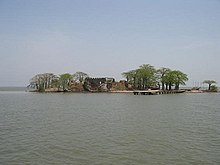James Island (Gambia)
| Kunta Kinteh Island and Related Sites | |
|---|---|
| Name as inscribed on the World Heritage List | |

James Island in 2004
|
|
| Type | Cultural |
| Criteria | iii, vi |
| Reference | 761 |
| UNESCO region | Africa |
| Coordinates | 13°19′03″N 16°21′41″W / 13.317464°N 16.361407°WCoordinates: 13°19′03″N 16°21′41″W / 13.317464°N 16.361407°W |
| Inscription history | |
| Inscription | 2003 (27th Session) |
Kunta Kinteh Island, formerly James Island, is an island in the Gambia River, 30 km from the river mouth and near Juffureh in the country of the Gambia. Fort James is located on the island. It is less than two miles from Albreda on the river's northern bank.
The first European settlers on the island came from Duchy of Courland and Semigallia, a vassal state of the Polish–Lithuanian Commonwealth, who also had other colonial possessions in the area, though the English Crown had previously granted the island to two separate companies in 1588 and 1618. In 1651, the settlers built a fort that they named Jacob Fort after Jacob Kettler, the Duke of Courland, and used it as a trade base. The Dutch briefly held the fort from 1659 until the English captured it in 1661; the Dutch formally ceded the fort to the English in 1664.
The English renamed the island James Island and the fort Fort James after James, the Duke of York, later King James II of England. The chartered Royal Adventurers in Africa Company administered the territory, which initially used it for the gold and ivory trade, and later in the slave trade. On 1 August 1669, the Company sublet the administration to the Gambia Adventurers. In 1684, the Royal African Company took over the Gambia's administration.
...
Wikipedia

